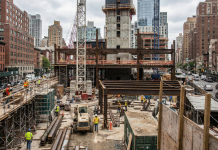Why Housing Demand Froze Mid-Flight
Residential projects across the country sit approved and financed but unbuilt. Developers haven’t gone bankrupt. Permits haven’t expired. Materials remain available.
Instead, projects exist in a new kind of market limbo. Borrowing costs have doubled financing burdens. Regulatory delays stretch timelines by months. Labor shortages push completion dates well into the future.
Construction demand didn’t collapse or surge. It suspended mid-flight.
Market indicators point in opposite directions
Mortgage rates will stay “well over 6%” through 2025. Home sales have dropped to nearly 30-year lows. Yet the market hasn’t crashed.
Meanwhile, input prices jumped 9.7% this year alone. Materials now cost 40% more than they did in 2020. Steel, copper, and lumber prices keep climbing.
Underlying demand remains strong.
Three forces creating market suspension
I’ve been tracking what’s freezing normal market dynamics. The causes aren’t mysterious, but their combined effect is unprecedented.
Borrowing costs create an artificial ceiling on buyer activity. Projects that penciled out at 3% rates become impossible when rates hit 6.5%. Monthly debt service can double, making previously viable developments financially unworkable.
Regulatory friction adds unpredictable delays everywhere. Department of Energy clearances that used to take weeks now stretch to months. Permitting backlogs and compliance requirements create timeline uncertainty that kills project confidence before ground breaks.
The worker shortage amplifies every other problem. The industry needs 439,000 new workers in 2025 just to meet current demand. General contractors are turning down work because they can’t staff projects through completion.
How successful firms are adapting
Construction professionals are finding ways to operate in this suspended market. The strategies that work share one common thread: they assume volatility is permanent.
Material cost management has become critical. With 9.7% annual price increases, every month of delay costs real money. Smart firms are locking in steel and lumber prices through longer-term contracts, accepting premiums to avoid future spikes. Project margins improve when competitors get caught in price escalations.
Timeline planning now includes regulatory buffer time as standard practice. Successful firms add 20-30% to normal permitting schedules. Commercial developers are factoring Department of Energy clearance delays into every project from day one, treating extended delays as baseline rather than exception.
Workforce development has become a competitive advantage. Companies investing in training and retention now will outperform competitors when demand returns. Some residential builders are starting apprenticeship programs during the slowdown, ensuring skilled labor availability when projects restart.
Project diversification provides stability during residential market suspension. Commercial and infrastructure work offers more predictable timelines and less regulatory friction than residential development.
Either rates drop and demand surges, or economic pressure forces a correction. Both scenarios will happen quickly when they come.
Normal growth patterns don’t apply in suspended markets. Professionals who adapt their planning and pricing to this reality will capture disproportionate market share when momentum returns.
Preparing for the inevitable shift
Traditional indicators don’t predict what happens next because we’re operating under artificial constraints rather than natural market forces.
The most important decision construction leaders can make is treating current stability as temporary. Plan for rapid movement in either direction. Build flexibility into operations that can scale up or down quickly. Maintain relationships with suppliers and subcontractors who will be essential when projects restart.
Keep your workforce engaged through training and development. The companies that emerge strongest from this suspension will be those that used the pause to improve capabilities rather than just survive.
Start preparing now. When this market moves, it will move faster than anyone expects.
Developers are using delays to redesign for better efficiency and secure better subcontractor rates. When rates drop or regulations streamline, they’ll be ready to move immediately.
The question isn’t whether this suspension will end. It’s whether you’ll be positioned to capitalize when it does.








